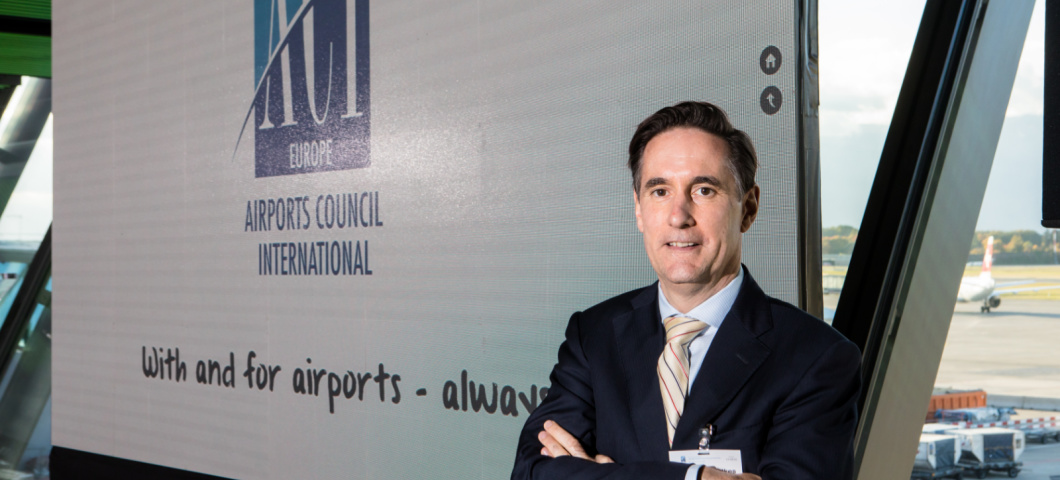
Assess the impact, reap the rewards
Morgan Foulkes, Deputy Director General of ACI EUROPE, puts the Fit for 55 package under the microscope
The European Union’s Fit for 55 package, proposed in the summer by the European Commission, sets out a plan to reduce net greenhouse gas emissions by 55% with a 2030 target date. ACI EUROPE, long the champion of, and first-mover in, the considerable challenge of decarbonising aviation, supports the objectives and the ambition of this package. It is, after all, broadly consistent with the European aviation industry’s Destination 2050 roadmap which we published early in 2021.
However, as the old adage goes, ‘more haste less speed’. It’s vital that a comprehensive impact assessment of all the proposals taken together is undertaken. This is neither the time nor the topic for unanticipated consequences. An analysis of the impact of these measures on our sector is both necessary and long overdue. And the rewards of a complete understanding would be significant. It would bring about a better understanding of the risks of competitive distortion between EU and non-EU hubs – crucially important for the Union’s economic strength. And no one wants to see risk of carbon leakage.
Looking at the individual proposals of the package, could some areas be further improved upon? We believe so. In particular, we have urgent concerns about the roles and responsibilities of the different actors of the air transport system in the Refuel EU and the AFIR proposals. Both proposals appear to be inconsistent with an existing piece of legislation, namely the 1996 Groundhandling Directive. With regard to Refuel EU in particular, the reality is that European airports are for the most part not engaged in fuelling activities and they do not own the fuelling infrastructure at the airport. So, the proposed obligation on airports to provide fuel infrastructure is not in line with the reality of operations today in Europe. Under the Groundhandling Directive the handling/fueling company – not the airport – is responsible for the quality, organisation and storage of the fuel provided to airlines. There is also no contractual relationship between the handling company and the airport. We’re all aware of what happens when one piece of legislation contradicts another – years of messy compromise with no solution quite achieving the intended goal. Let’s not go there again.
Then there’s the money conversation. Of course it comes as no surprise that there’s a cost side to the Fit for 55 proposals, and reaching its objectives is entirely dependent on our sector’s ability to finance it. Airports have historically dug deep to finance sustainability investment, and have continued to find ways to do so even through the worst of the crisis. But we cannot take this as a given. European airports are transitioning out of this crisis with a 200% increase in debt in just 2 years. Airports had to remain open during the crisis and financed their operations through debt. Let’s not forget that unlike the experience of some of the airlines, Governments are not picking up the debt for European airports, around half of which have private stakeholders.
This year European airports are set to lose another €29 billion in revenue and passenger numbers remain very depressed. We have entered an era of systemic financial weakness for European airports and airport revenues will be insufficient to meet capital expenditure and capital costs until 2032. No, those numbers are not transposed, it really will be 11 years away. On the other hand, the cost of reaching net zero by 2050 for terminal buildings alone is estimated to be €26 billion for the top 50 European airports. Within this context, public funding will be crucial to complement the private investment efforts of the industry.
These are the harsh realities, and it doesn’t make for easy reading. So let me end on a positive. Airports are resilient, innovative and determined, with a pivotal role to play in the societies and economies in which they sit. And they lead and contribute accordingly. Here are some nicer numbers to digest. Since 2009, European airports have actively reduced carbon emissions within their control through Airport Carbon Accreditation. 193 European airports are accredited and 46 airports are carbon neutral for operations under their control. In the programme’s last annual reporting period, accredited airports in Europe have collectively reduced the emissions under their control by 154,432 tonnes of CO2, which represents a 7.9% decrease. What’s more, 10 Swedish airports have gone beyond carbon neutrality and are Net Zero today, which means that they did not use offsets. Another 84 European airports are set to become Net Zero by 2030 and a total of 242 airports by 2050.
So let’s make sure that the ambitions and the objectives of Fit for 55 enhance what’s already there. An impact assessment which takes the holistic view of the measures taken as a whole will ensure that these initiatives will complement each other, and eventually be greater than the sum of their parts.
Now that will be a result in everyone’s interests.



